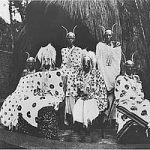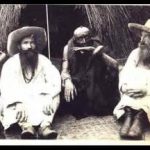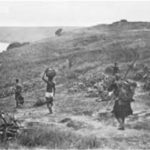The Cow As Token
Tostand alone is a tragedy. For sheer survival, the weaker individuals or lineages are driven to beg for a cow from someone more powerful than themselves. Asking for a cow is the equivalent of asking for material acknowledgment on the part of a patron that he is indeed granting protection to his client. Receiving a cow, therefore, means to the weaker party that, atlast, he is granted the protection he is seeking. He will not be driven off his lands or be prevented from cultivating them. It means that he acknowledges his own inferior weaker — position, and therefore he will serve and pay his “dues”; he acknowledges the amaremborights that his patron has on his produce, his livestock, his bananas, and his labor, etc.
The patron is expected to replace this cow if it dies. If he does not replace it, or if he withdraws the cow, if may be the equivalent of exacting forfeiture (kunyaga). It means that he refuses to protect his client any longer. It is the sign for the client to seek another patron.
But contrary to what is generally believed, it is not the “gift” of a cow that determines the nature of a relationship, it is the relationship (or the relative status) of donor and recipient that determines the nature of the “gift”. A cow might be handed down a step in the hierarchy from a patron to his client and record that relationship. In the same way it also can be passed up the hierarchy, in which case it records an entirely new relationship, ormeans nothing at all until it is handed down again. Passing up a cow could undo the relationship, if the “gift” has been forfeited, but not if the passing up involved an act other than forfeiture.
All depends on the manner, the occasion, and the status of the participants. This is easily shown by a simple listing of a few institutionalized “gifts” of cows:
(1)A Tutsi arriving on a Hill starts paying court by immediately giving a cow to the chieftain. The chieftain, in turn, gives the Tutsi an igikingi, after which the Tutsi pays court to the chieftain, receives a cow from the chieftain and is infeudated.
(2)There are various occasions, such as a birth or a death in the chieftain’s family which require his Tutsi clients to give him a cow.
(3)If a chieftain is lacking cows with which toinfeudate a client, he can request a cow from a man of equal rank and status as himself. This is termed a “friendship” cow and only implies that sometime in the future the chieftain will reciprocate.
(4)When a new chieftain takes over his position as chieftain, the Tutsi of his Hill are expected to each give him a cow in sign of submission.
(5)Second, third, fourth, etc… cows can be given by a patron in recognition of the faithfulness of his client.
It is difficult to appreciate exactly what the various institutions of cow-giving and cow-exchange mean to the Banyaremera. it might be possible to understand by a process of elimination, i.e., by first stating what cows do not mean. Cows, obviously, are not primarily wealth; they might be considered as wealth only in the sense that they have a market value. In the light of what is known of them as recording devices, however, their production utility and exchange value becomes insignificant. Nor are they an indirect means of obtaining produce and work. They are not the equivalent of writing, nor are they a mnemonic device; but it can be said that they are in the same class of things in that they materialize a situation, thus facilitating its institutionalization.
“Token” will be taken to refer to a testimony, so to speak, serving as proof of authenticity. By comparison, a symbol would be restricted to the sense of an abject having a conceptual significance based on a relationship obvious to those who are speaking, e.g., the anchor is the symbol of salvation, the dog is the symbol of loyalty. Cows are tokens which concrete an existing situation, whether it is a situation of “friendship” or vassalage. Each cow has a name and a history which is carefully followed. Not only is the history of its comings and goings from one person to another remembered, but also the history of its progeny. This very concern for remembering the history of a cow serves as a means of keeping social relations straight. This is the reason, in the case of vassalage, why the progeny of each cow held by the progeny of the client can be kunyagaby the progeny of the patron. The relationship remains “present” in the animal, but only in the sense that it is recorded in the history of the transfers of the cow. Thus, the cow is no more the symbol of what it records than a thermometer is the symbol of temperature. Butthis does not mean that if cannot become the symbol of the institution in which it plays such a great role, but that is another story.
Complex as such a code is, if is, however, further complicated by the fact that cows are used as token recorders in an entirely distinct system: that of bride-pricing. Sometimes the two systems are allowed to meet, risking the danger of interference of one system with the other.
https://uk.amateka.net/the-cow-as-token/https://uk.amateka.net/wp-content/uploads/2021/06/gift-cows.jpghttps://uk.amateka.net/wp-content/uploads/2021/06/gift-cows-150x150.jpgModel CitizenshipTostand alone is a tragedy. For sheer survival, the weaker individuals or lineages are driven to beg for a cow from someone more powerful than themselves. Asking for a cow is the equivalent of asking for material acknowledgment on the part of a patron that he is indeed granting...BarataBarata rpierre@ikaze.netAdministratorAMATEKA | HISTORY OF RWANDA




